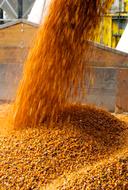DOE issues notice of intent to fund industrial partnerships across the bioenergy and bioproducts value chain
The DOE has announced its intent to fund partnerships between industry stakeholders and Feedstock-Conversion Interface Consortium researchers. The partnerships will address the cost and risk impacts of feedstock and process variability.
Ag groups call on Treasury to include domestic feedstock requirements in 45Z guidance and unbundle climate-smart ag provisions
U.S. farm groups are urging the Biden administration to maximize the benefits of the 45Z clean fuels production tax credit by ensuring only fuels made using domestically produced feedstocks are eligible and improving climate-smart ag provisions.
Ethanol holds promise as an SAF feedstock, due in no small part to its availability of supply relative to lipid feedstocks, which are feeling global pressure.
Advised by several former CEOs from big-name companies, Avina Clean Hydrogen is on an ambitious lateral pursuit in Illinois: sustainable aviation fuel production via ETJ.
A new U.S. DOE report helps answer a basic—but big—question about the future of the U.S. SAF industry: Is there enough biomass feedstock to meet the nation’s goals?
CoBank maintained its positive outlook for U.S. ethanol production in its latest Quarterly Research Report, released July 11, with higher margins and a strong export market continuing to benefit ethanol producers.
CF Industries and POET to demonstrate the use of low-carbon fertilizer in corn production to reduce carbon intensity of ethanol
CF Industries Holdings Inc. and POET LLC on July 15 announced a collaboration to pilot the use of low-carbon ammonia fertilizer to reduce the carbon intensity of corn production and ethanol. The project is expected to kick off this fall.
In June, the industry gathered in Minnesota for the largest, longest-running ethanol conference in the world. After four decades, the FEW remains a can’t-miss early summer event for ethanol plant personnel and the companies that support them. Photos: BBI/Sarah Morreim
The USDA maintained its forecast for 2024-’25 corn use in ethanol production in its latest WASDE report, released July 12. The agency increased its forecast for corn production and reduced its forecast for corn prices.
ARPA-E awards $36M to develop technologies to lower GHG from ethanol production, reduce operating costs for US farmers
The Advanced Research Projects Agency-Energy (ARPA-E) on July 11 announced up to $36 million in funding to develop technologies to lower nitrous oxide (N2O) emissions by 50% from the cultivation of corn and sorghum used for U.S. ethanol production.
IATA: South Africa has vast potential for SAF production
The International Air Transport Association has called on South Africa to mobilize its experience, resources, and infrastructure to accelerate the development of sustainable aviation fuel (SAF) production.
UNICA, the Brazilian sugarcane industry association, has released data showing that sugarcane processing, ethanol production and ethanol sales were up during the first half of June when compared to the same period of 2023.
U.S. operable biofuels production capacity increased in April, with gains for ethanol, biodiesel and renewable diesel, according to data released by the U.S. EIA on June 28. Feedstock consumption was down from the previous month.
The U.S. has enough biomass potential to produce 35 billion gallons per year of aviation biofuel by 2050, a new report confirms. Oak Ridge National Laboratory’s John Field provided biomass feedstock production expertise within the report.
The USDA’s NASS estimates that 91.5 million acres of corn will be planted in the U.S. for 2024, down 3% or 3.17 million acres when compared to last year, according to the agency’s annual Acreage report, which was released June 28.
The USDA on June 26 launched a RFI seeking public comments on procedures for quantifying, reporting and verifying the effect of climate-smart farming practices on the GHG emissions associated with U.S.-grown biofuel feedstocks.
The USDA recently released its Grain Crushings and Co-Products Production report for June, reporting that corn use for fuel ethanol production in April was up slightly when compared to the same month of last year.
UNICA, the Brazilian sugarcane industry association, has announced sugarcane processing dipped slightly during the second half of May. Ethanol production and sales, however, continued to trend above last year.
The USDA maintained its forecast for 2024-’25 corn use in ethanol in its latest World Agricultural Supply and Demand Estimates report, released June 12. The overall 2024-’25 U.S corn outlook was also unchanged relative to last month.
Ethanol Producer Magazine values opportunities to report on ethanol producers whenever possible, and earlier this summer we were fortunate to visit with three of them—each having some connection to high-purity alcohol.
A dairy producer in Michigan is partnering with a vodka manufacturer to make low-carbon ethanol out of a dairy byproduct.
UNICA, the Brazilian sugarcane industry association, has announced that the volume of sugarcane processed during the first half of May was consistent with the same period of 2023. Ethanol production was up slightly, and sales were up significantly.
U.S. biofuels operable production capacity expanded slightly in March, according to data released by the U.S. Energy Information Administration on May 31. Feedstock consumption was up when compared to both the previous month and March 2023.
USDA publishes request for information to support next steps in implementing the Growing Climate Solutions Act
The USDA is seeking information from the public on protocols that may be considered for inclusion in a new Greenhouse Gas Technical Assistance Provider and Third-Party Verifier Program, the main program of the Growing Climate Solutions Act.
The USDA recently released its Grain Crushings and Co-Products Production report for May, reporting corn fuel ethanol production in March was up when compared to both the previous month and the same month of last year.
UNICA, the Brazilian sugarcane industry association, has announced sugarcane processing was up during the second half of April. Ethanol production from both sugarcane and corn feedstocks was also up during the two-week period.
The USDA expanded its estimate for 2023-’24 corn use in ethanol to 5.45 billion bushels in its latest WASDE report, released May 10. The agency currently expects the volume of corn that goes to ethanol production to remain at that level for 2024-’25.
The USDA’s Agricultural Research Service, the University of Nebraska–Lincoln, and Nebraska Innovation Campus on May 6 celebrated the groundbreaking of the National Center for Resilient and Regenerative Precision Agriculture.
Brazil’s 2024-’25 sugarcane harvest season kicked off on April 1. UNICA, the country’s sugarcane industry association, said sugarcane processing and ethanol production were both up during the first two-weeks of the harvest season.
The USDA recently released its Grain Crushings and Co-Products Production Report for March, reporting that corn use for fuel ethanol production in February was up when compared to both the previous month and February 2023.
Advertisement





















